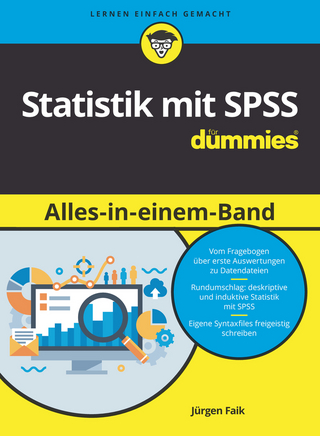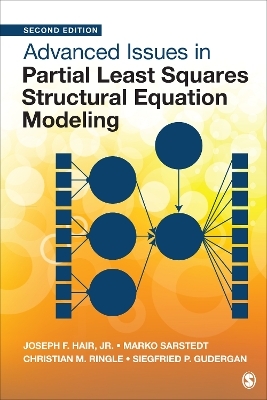
Using IBM® SPSS® Statistics
SAGE Publications Inc (Verlag)
978-1-4833-8357-6 (ISBN)
- Titel erscheint in neuer Auflage
- Artikel merken
For those who have a basic understanding of statistics and want to learn SPSS on their own, this concise, practical guide can be used in conjunction with another text or as a self-instructional resource. With the assistance of ample screenshots, bullet points, and callouts, readers master SPSS by inputting and analyzing their own data, rather than simply opening existing databases. The Second Edition introduces advanced concepts such as Logistic Regression, Principal Components Factor Analysis, and more complex graphing methods. This edition is compatible with IBM SPSS versions through 23.
James O. Aldrich (Doctor of Public Administration, University of Laverne) is a retired lecturer on statistics and research methods at California State University, Northridge. He has also taught graduate level research courses for the University of La Verne. Dr. Aldrich held the appointment of Instructor in the Department of Pathology at the University of Southern California, School of Medicine where he served as the Principal Investigator and codirector of a National Cancer Institute research project. He has served on various committees for the Los Angeles chapter of the American Statistical Association and has also taught biostatistics, epidemiology, social statistics, and research methods courses for 20 years. The primary computer program used for his coursework has been the IBM SPSS Statistics software package. SAGE recently published, in 2013, Building SPSS Graphs to Understand Data, coauthored with Hilda M. Rodriguez. James B. Cunningham (PhD in Science Education, Syracuse University) is Professor Emeritus of Science and Computer Education and former chair of the Department of Secondary Education at California State University, Northridge. Formerly chair of the Departments of Science and Mathematics in Washington State high schools, he is author of Teaching Metrics Simplified and co-author of BASIC for Teachers, Authoring Educational Software, Hands-On Physics Activities With Real-Life Applications, and Hands-On Chemistry Activities With Real-Life Applications. He used SPSS extensively during his tenure as director of the Credential Evaluation Unit in the College of Education. He is currently a Fellow in the Center for Teaching and Learning at California State University, Northridge.
Preface
Acknowledgments
About the Authors
Chapter 1. First Encounters
1.1 Introduction and Objectives
1.2 Entering, Analyzing, and Graphing Data
1.3 Summary
1.4 Review Exercises
Chapter 2. Navigating in SPSS
2.1 Introduction and Objectives
2.2 SPSS Variable View Screen
2.3 SPSS Data View Screen
2.4 SPSS Main Menu
2.5 Data Editor Toolbar
2.6 Variable View Screen: A Closer Look
2.7 Summary
2.8 Review Exercises
Chapter 3. Getting Data In and Out of SPSS
3.1 Introduction and Objectives
3.2 Typing Data Using the Computer Keyboard
3.3 Saving Your SPSS Data Files
3.4 Saving Your SPSS Output Files
3.5 Opening Your Saved SPSS Files
3.6 Opening SPSS Sample Files
3.7 Copying and Pasting Data to Other Applications
3.8 Importing Files From Other Applications
3.9 Exporting SPSS Files to Other Applications
3.10 Summary
3.11 Review Exercises
Chapter 4. Levels of Measurement
4.1 Introduction and Objectives
4.2 Variable View Screen: Measure Column
4.3 Variables Measured at the Nominal Level
4.4 Variables Measured at the Ordinal Level
4.5 Variables Measured at the Scale Level
4.6 Using SPSS to Suggest Variable Measurement Levels
4.7 Summary
4.8 Review Exercises
Chapter 5. Entering Variables and Data and Validating Data
5.1 Introduction and Objectives
5.2 Entering Variables and Assigning Attributes (Properties)
5.3 Entering Data for Each Variable
5.4 Validating Data for Databases
5.5 Summary
5.6 Review Exercises
Chapter 6. Working With Data and Variables
6.1 Introduction and Objectives
6.2 Computing a New Variable
6.3 Recoding Scale Data Into a String Variable
6.4 Data Transformation
6.5 Split Cases for Independent Analysis
6.6 Inserting New Variables and Cases Into Existing Databases
6.7 Data View Page: Copy, Cut, and Paste Procedures
6.8 Summary
6.9 Review Exercises
Chapter 7. Using the SPSS Help Menu
7.1 Introduction and Objectives
7.2 Help Options
7.3 Using Help Topics
7.4 Using the Help Tutorial
7.5 Using Help Case Studies
7.6 Getting Help When Using Analyze on the Main Menu
7.7 Summary
7.8 Review Exercises
Chapter 8. Creating Graphs for Nominal and/or Ordinal Data
8.1 Introduction and Objectives
8.2 A Brief Introduction to the Chart Builder
8.3 Using the Chart Builder to Build a Simple 3-D Graph
8.4 Building a Population Pyramid
8.5 Summary
8.6 Review Exercises
Chapter 9. Graphs for Continuous Data
9.1 Introduction and Objectives
9.2 Creating a Histogram
9.3 Creating a Boxplot
9.4 Creating a Panel Graph
9.5 Summary
9.6 Review Exercises
Chapter 10. Printing Data View, Variable View, and Output Viewer Screens
10.1 Introduction and Objectives
10.2 Printing Data From the Variable View Screen
10.3 Printing Variable Information From the Output Viewer
10.4 Printing Tables From the Output Viewer
10.5 Summary
10.6 Review Exercises
Chapter 11. Basic Descriptive Statistics
11.1 Introduction and Objectives
11.2 Measures of Central Tendency
11.3 Measures of Dispersion
11.4 The Big Question: Are the Data Normally Distributed?
11.5 Descriptive Statistics for the Class Survey
11.6 Summary
11.7 Review Exercises
Chapter 12. One-Sample t Test and a Binomial Test of Equality
12.1 Introduction and Objectives
12.2 Research Scenario and Test Selection
12.3 Research Question and Null Hypothesis
12.4 Data Input, Analysis, and Interpretation of Output
12.5 Nonparametric Test: The Binomial Test of Equality
12.6 Summary
12.7 Review Exercises
Chapter 13. Independent-Samples t Test and Mann-Whitney U Test
13.1 Introduction and Objectives
13.2 Research Scenario and Test Selection
13.3 Research Question and Null Hypothesis
13.4 Data Input, Analysis, and Interpretation of Output
13.5 Nonparametric Test: Mann-Whitney U Test
13.6 Summary
13.7 Review Exercises
Chapter 14. Paired-Samples t Test and Wilcoxon Test
14.1 Introduction and Objectives
14.2 Research Scenario and Test Selection
14.3 Research Question and Null Hypothesis
14.4 Data Input, Analysis, and Interpretation of Output
14.5 Nonparametric Test: Wilcoxon Signed-Ranks Test
14.6 Summary
14.7 Review Exercises
Chapter 15. One-Way ANOVA and Kruskal-Wallis Test
15.1 Introduction and Objectives
15.2 Research Scenario and Test Selection
15.3 Research Question and Null Hypothesis
15.4 Data Input, Analysis, and Interpretation of Output
15.5 Nonparametric Test: Kruskal-Wallis Test
15.6 Summary
15.7 Review Exercises
Chapter 16. Two-Way (Factorial) ANOVA
16.1 Introduction and Objectives
16.2 Research Scenario and Test Selection
16.3 Research Question and Null Hypothesis
16.4 Data Input, Analysis, and Interpretation of Output
16.5 Summary
16.6 Review Exercises
Chapter 17. One-Way ANOVA Repeated Measures Test and Friedman Test
17.1 Introduction and Objectives
17.2 Research Scenario and Test Selection
17.3 Research Question and Null Hypothesis
17.4 Data Input, Analysis, and Interpretation of Output
17.5 Nonparametric Test: Friedman Test
17.6 Summary
17.7 Review Exercises
Chapter 18. Analysis of Covariance
18.1 Introduction and Objectives
18.2 Research Scenario and Test Selection
18.3 Research Question and Null Hypothesis
18.4 Data Input, Analysis, and Interpretation of Output
18.5 Summary
18.6 Review Exercises
Chapter 19. Pearson’s Correlation and Spearman’s Correlation
19.1 Introduction and Objectives
19.2 Research Scenario and Test Selection
19.3 Research Question and Null Hypothesis
19.4 Data Input, Analysis, and Interpretation of Output
19.5 Nonparametric Test: Spearman’s Correlation Coefficient
19.6 Summary
19.7 Review Exercises
Chapter 20. Single Linear Regression
20.1 Introduction and Objectives
20.2 Research Scenario and Test Selection
20.3 Research Question and Null Hypothesis
20.4 Data Input
20.5 Data Assumptions (Normality)
20.6 Regression and Prediction
20.7 Interpretation of Output (Data Assumptions)
20.8 Interpretation of Output (Regression and Prediction)
20.9 Research Question Answered
20.10 Summary
20.11 Review Exercises
Chapter 21. Multiple Linear Regression
21.1 Introduction and Objectives
21.2 Research Scenario and Test Selection
21.3 Research Question and Null Hypothesis
21.4 Data Input
21.5 Data Assumptions (Normality)
21.6 Regression and Prediction
21.7 Interpretation of Output (Data Assumptions)
21.8 Interpretation of Output (Regression and Prediction)
21.9 Research Question Answered
21.10 Summary
21.11 Review Exercises
Chapter 22. Logistic Regression
22.1 Introduction and Objectives
22.2 Research Scenario and Test Selection
22.3 Research Question and Null Hypothesis
22.4 Data Input, Analysis, and Interpretation of Output
22.5 Summary
22.6 Review Exercises
Chapter 23. Factor Analysis
23.1 Introduction and Objectives
23.2 Research Scenario and Test Selection
23.3 Research Question and Null Hypothesis
23.4 Data Input, Analysis, and Interpretation of Output
23.5 Summary
23.6 Review Exercises
Chapter 24. Chi-Square Goodness of Fit
24.1 Introduction and Objectives
24.2 Research Scenario and Test Selection: Legacy Dialogs
24.3 Research Question and Null Hypothesis: Legacy Dialogs
24.4 Data Input, Analysis, and Interpretation of Output: Legacy Dialogs
24.5 Research Scenario and Test Selection: One Sample
24.6 Research Question and Null Hypothesis: One Sample
24.7 Data Input, Analysis, and Interpretation of Output: One Sample
24.8 Summary
24.9 Review Exercises
Chapter 25. Chi-Square Test of Independence
25.1 Introduction and Objectives
25.2 Research Scenario and Test Selection: Summarized Data
25.3 Research Question and Null Hypothesis: Summarized Data
25.4 Data Input, Analysis, and Interpretation of Output: Summarized Data
25.5 Research Scenario and Test Selection: Raw Data
25.6 Research Question and Null Hypothesis: Raw Data
25.7 Data Input, Analysis, and Interpretation of Output: Raw Data
25.8 Summary
25.9 Review Exercises
Appendix A. Class Survey Database (Entered in Chapter 5)
Table A.1 Variables and Attributes for class_survey1.sav
Table A.2 Data for class_survey1.sav
Appendix B. Basic Inferential Statistics
B.1 Introduction
B.2 Populations and Samples
B.3 Sampling Procedures
B.4 Hypothesis Testing
B.5 Parametric Statistical Tests
B.6 Nonparametric Statistical Tests
B.7 Data Transformation
B.8 Type I and Type II Errors
B.9 Tests of Significance
B.10 Practical Significance Versus Statistical Significance
B.11 One- and Two-Tailed Tests
B.12 Degrees of Freedom
Appendix C. Answers to Review Exercises
Index
| Verlagsort | Thousand Oaks |
|---|---|
| Sprache | englisch |
| Maße | 187 x 231 mm |
| Gewicht | 700 g |
| Themenwelt | Mathematik / Informatik ► Mathematik ► Computerprogramme / Computeralgebra |
| ISBN-10 | 1-4833-8357-1 / 1483383571 |
| ISBN-13 | 978-1-4833-8357-6 / 9781483383576 |
| Zustand | Neuware |
| Informationen gemäß Produktsicherheitsverordnung (GPSR) | |
| Haben Sie eine Frage zum Produkt? |
aus dem Bereich



